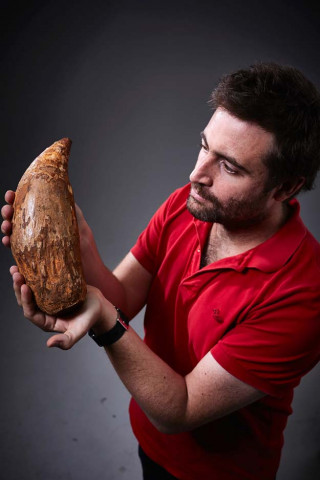Fossilised tooth of gigantic 'killer' whale found in Australia
Museum Victoria says the unique fossil belonged to an extinct species of "killer sperm whale"

This hand out picture released by Museum Victoria on April 22, 2016 shows Erich Fitzgerald, a paleontologist at the Museum Victoria, holding an extinct sperm whale tooth. PHOTO: AFP
The 30-centimetre-long (12-inch) fossilised tooth, which is larger than that of a Tyrannosaurus rex, was found by a fossil enthusiast at Beaumaris Bay near Melbourne in February.
Tusks found near Jhelum are 3 million years old, claims professor
"After I found the tooth I just sat down and stared at it in disbelief," Murray Orr said after the find was announced on Thursday by Museum Victoria, to whom he has donated the tooth.
"I knew this was an important find that needed to be shared with everyone."
Museum Victoria said the unique fossil belonged to an extinct species of "killer sperm whale" which would have measured up to 18 metres (60 feet) in length and weighed some 40 tonnes.
It is the only example ever found outside the Americas, it added.
"Until this find at Beaumaris all fossils of giant killer sperm whales were found on the west coast of South and North America," Erich Fitzgerald, a paleontologist at the museum, told the Australian Broadcasting Corporation.
The museum said the tooth, which dates from the Pliocene epoch of some five million years ago, was not only larger than those of a living sperm whale but also of a Tyrannosaurus rex.
Unlike today's sperm whales, which eat a diet of squid and fish, their extinct relatives are thought to have used their bone-crushing teeth to prey on much larger animals, including fellow whales.
Pakistan scientists 'find 1.1 million year-old stegodon tusk'
"If we only had today's deep-diving, squid-sucking sperm whales to go on, we could not predict that just five million years ago there were giant predatory sperm whales with immense teeth that hunted other whales," Fitzgerald said in a statement.
"Most sperm whales for the past 20 million years have been of the whale-killing kind. So, the fossil record reveals the living species to in fact be the exception to the rule, the oddball of the sperm whale family."
Fitzgerald said Beaumaris Bay was one of Australia's premier fossil sites, providing insights into the history of the continent's marine megafauna.

















COMMENTS
Comments are moderated and generally will be posted if they are on-topic and not abusive.
For more information, please see our Comments FAQ